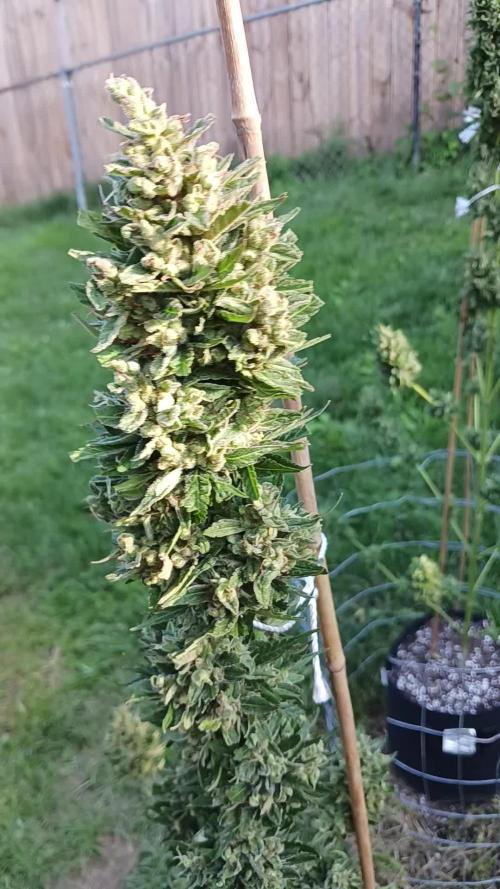The Grow Awards 2026 🏆 































Likes
Comments
Share


@grandeG
Follow
I put many identical photos to see the details, the next I will take them with a camera to make sure you see all the smallest details, it smells of citrus almost like smelling an orange, and the bright orange color and magnificent, it started this week to fill with trichomes, we see with the microscope and when it is ready after washing the cut and I will show you the result, too bad that the smell cannot be felt in a video
Likes
8
Share


@La_VecinaCannabica83
Follow
Van muy bien y muy sanas
Estos días les haré trasplante a maceta más grande.
Likes
20
Share


@The_Bearded_Grower
Follow
welcome to 📅 day 86 5/31/2021 harvest went great and now its all drying I will update in 3 days till then Happy Growing and keep your stick on the ice 🏒
Likes
5
Share


@BuddyHolly
Follow
Slight issue with roots. Flushed with Athena cleanse. Flipping to flower Friday. No new pics. Timelapse of weekly growth
Likes
93
Share


@PEAKYPLANTERS
Follow
Wo wo wo....stop everyone, friends! Stop for a second and admire my central zkittez that seems to be turning into a Christmas tree 😋
Very satisfied with this flowering start
Many greetings and good harvests for all
Likes
87
Share


@Wicked_Stix
Follow
The white widow is still smaller than the rest but she is looking good. She is back row center. Gave them a flush and fresh nutrients. Been pulling some leaves here and there to keep budsites open. Going to keep spreading her out as she grows. Will switch them to flower in a week.
Likes
20
Share


@420DeepGrow
Follow
Gracias al equipo de Royal Queen Seeds, Marshydro, XpertNutrients y Trolmaster sin ellos esto no sería posible.
💐🍁Punch Pie:
Un híbrido monstruoso con un 90% de dominancia índica, ocupa uno de los primeros puestos de la lista de favoritas de Kid Dynamite.
La Punch Pie desciende de la Cherry Punch Pie de Tyson 2.0 y contiene la genética de dos índicas galardonadas: la Purple Punch y la Purple Kush.
Punch Pie tu paladar se impregnará con ricas notas de pastel de frutos rojos, repostería caramelizada y tierra. Luego, pocos minutos después de la primera calada, sentirás todo el poder de este portento. La Punch Pie proporciona un combo 1-2 que se manifiesta justo en medio de los ojos y derrite todo el cuerpo, dejándote en un estado somnoliento, hambriento y apacible.
Produce plantas compactas que alcanzan una altura de 80-110cm en interior y hasta 120-150cm en exterior. Tras 9 semanas de floración, esta señorita robusta crece con fuerza para soportar el peso de sus densas flores, y da cosechas de hasta 600g/m² en interior y 750g por planta en exterior bajo el sol.
💡TS-3000 + TS-1000: se usaran dos de las lámparas de la serie TS de Marshydro, para cubrir todas las necesidades de las plantas durante el ciclo de cultivo, uso las dos lámparas en floracion para llegar a toda la carpa de 1.50 x 1.50 x 1.80.
https://marshydro.eu/products/mars-hydro-ts-3000-led-grow-light/
🏠 : Marshydro 1.50 x 1.50 x 1.80, carpa 100% estanca con ventanas laterales para llegar a todos los lugares durante el grow
https://marshydro.eu/products/diy-150x150x200cm-grow-tent-kit
🌬️💨 Marshydro 6inch + filtro carbon para evitar olores indeseables.
https://marshydro.eu/products/ifresh-smart-6inch-filter-kits/
💻 Trolmaster Tent-X TCS-1 como controlador de luz, optimiza tu cultivo con la última tecnología del mercado, desde donde puedes controlar todos los parametros.
https://www.trolmaster.com/Products/Details/TCS-
🍣🍦🌴 Xpert Nutrients es una empresa especializada en la producción y comercialización de fertilizantes líquidos y tierras, que garantizan excelentes cosechas y un crecimiento activo para sus plantas durante todas las fases de cultivo.
Consigue aqui tus Nutrientes:
https://xpertnutrients.com/es/shop/
📆 Semana 1:
Ha sido una buena semana, ella ha dado otro gran cambio en su lugar definitivo 😎.
La carpa está ocupada al 75% y comienza una floracion explosiva gracias a @Marshydro y @Xpertnutrients y @Trolmaster con esta gran genética 💪.
A partir de ahora se riega manualmente con las dosis recomendadas por el fabricante.
Likes
8
Share


@Mon_monde_onirique
Follow
Purple shine a bien repris son développement, niveau racines il va être temps de la rempoter une bonne masse racinaire commence à sortir du air pot.
Le 25/04 seconde taille des branches principales, de 2 apex cela va passer à quatre😉,
apport de solution nutritive pour réduire le stress de la taille(terragrow 1,5ml, katanaroot 0,2ml, silicon 1ml, calmag 0,5ml). Maintenant repos pour cette demoiselle avant la prochaine taille😉
Purple shine semble reprendre assez vite sa végétation après une taille. Ses branches sont bien épaisse ajout de silice et a participé.
Likes
21
Share


@PabloTheGrower
Follow
Sticky sticky and smelly smelly, can't say much more.
Buds are densing up quite nicely and theres a lot o resin production. I always find the strain names quite dumb, but this actually has hints of coke in it's smell. Very sweet and fresh.
I raised the EC to 0.95 considering my water was on 0.25, so plus 0.7 of nutrients and the light is at 100%, putting roughly 750 ppf average.
See you guys next week and good grows.
Likes
47
Share


@Northern_Ent
Follow
Sep 7: what a great plant. Totally love how it’s going. Flowers keep getting fatter and heavier and she’ll be done before the end of September.
Sep 8: there a tree root sticking up a bit in my yard which means the plant can be tilted toward the late afternoon sun. This is helpful because the sun is getting really low to the horizon already and we’re down to 13 h of daylight. Plus now direct sun is done in my yard by about 6 pm. Indirect light is okay but you really want direct sun at all times.
Videos shows use of 730 nm far red light at dusk. Just a few seconds is all it takes to set the plant into dark mode two hours faster. It’s a bloom booster because you get two bonus hours of darkness or a 26 h day. Very effective but don’t miss a night and you have to adjust the timing each night.
When starting this on July 20 Civil Twilight, as listed on timeanddate.com for my location, was at 9:45 and today it was at 8:40 pm. The red light at dusk is a highly recommended trick if you have daily access to your outdoor plants. Also works indoors, of course, and on autos too.
Also I think it helps ‘stabilize’ the plant by emphatically putting it into dark mode, and therefore less susceptible to stray light to cause a hermie. Have not had hermie problems in four seasons of using the red light so that is my only ‘proof’ but it is true so far, even with taking flash pics before using the red light.
Sep 9: getting heavier and now more branches are weighed down and slumping against the scrog net. Nice problem to have, I know, and without the scrog net some of the branches would be breaking off now.
She’s now officially too big and too top heavy to keep moving around the yard in pursuit of direct sun. Sun is much lower to horizon now and direct sun hours are dropping too.
Sep 10: getting close to done and getting very top heavy. Awesome.
Sep 12: raining today. Has been cool last few nights and some purple colour is just starting to show.
I don’t want to overdo fertilizer near the end, but I decided she is showing K deficiency. I’m out of malted barley but I still have potassium silicate, so I used that and some cal-mag. I’m avoiding kelp and molasses or using more P at this late stage because that can make the dried bud hard to burn and that really sucks. So, potassium silicate and cal-mag it is. The potassium silicate raises the pH and it takes about the same volume of vinegar to get the pH down. A good does of acetate is likely good for the bugs in the soil too. Then a squirt of Dr Bronners soap as a surfactant and that also supplies some biodegradable carbon for the bugs in the soil. Seems to work overall and is cheap.
Apologies for the large number of pics, but she’s so photogenic. 😎
#seedsman420growoff
#seedsmanseeds
Likes
Comments
Share


@AlbStoned
Follow
Die Letzten paar Tage sind gekommen. Ich habe auf beiden Pflanzen braune Trichome, und warte nun das Verhältnis 30/70 ab. Der Geruch ist echt der Hammer! Beide Pflanzen geben eine sehr süßliche Note ab. Die Mango Cream x Cinderella wird momentan noch die letzten Blätter los, und besteht fast nur noch aus Buds.
Likes
13
Share


@3lementa1
Follow
I realized there may have been a bit of a light leak in the late morning. I taped everything up more. In the future I want to maintain better reflective integrity on the inside of the tent.
Everything looks good. The buds are still growing a little taller and filling out. The CBD Blue Shark is super frosty. It's actually absurd. Orange hairs are coming out in all plants.
I was hoping to be able to keep the exhaust window open overnight to let the overnight temps drop 10 degrees to encourage the purples in the WC genetics, but it's too humid now to have the window open without the grow light on. Otherwise the rh goes up to 70% overnight and it's not worth the risk. Next year I'll flip earlier when it's still colder and drier out for the harvest window.
This flowering period has been really cool. I've really been noticing the process of flowering. The calyxes open up and turn into pistils and sugar leaves, and more keep appearing and popping every day. It's awesome.
Likes
5
Share


@HegauHillsFarmers_D23
Follow
Die Pflanze hat sich in dieser Woche extrem gestreckt.🌱
Zudem sind vermehrt Stempel aufgetreten.👀
Sie benötigt jetzt auch mehr Dünger für die Blüte, deshalb habe ich den Blühstimulator von Advanced Nutriens nochmal erhöht.💪🏻
Vodoo Juice habe ich ab dieser Woche durch B-52 ersetzt und somit ihr mehr Vitamine und Aminosäuren gegeben für eine Stressfreie Blütenproduktion.🍁🌲
Likes
26
Share


@BrMarijuana
Follow
Devido a Rega a cada dois dias, resolvi fracionar a dosagem semanal de fertilização para toda Rega, sendo assim, rego a cada dois dias da semana, totalizando três regas semanais, com isso fraciono a dosagem para 2ml líquido e 0,16g de mineral a cada litro d'água, totalizando 6ml líquido e 0,50g de mineral por semana.
Likes
46
Share


@StoneyMelony
Follow
Overview of my grow:
Tent: Secret Jardin DS120 4 x 4 (120 cm by 120 cm)
Lights: 2 x 120 Watt CTlite c4 clusterled
Climat: Trotec Dehumidifyer 240 watt- 10L/24h
Filter: Prima Klima carbon filter PK2600
fan: 2 x Secret Jardin 20watt osc. fan
Pots: Gronest 4 x 11 liter airpots
Water : automated water system
PH: bluelab
Nutrients: Plagron cocos A + B
Plagron PK 13/14
ATA cal/mag
Epsom salt
no rights to music in the videos
Week 9 She is a beautifull plant, she smells delicious very sweet it reminds me of the auto Lemon Kix like candy. I'm looking forward to the taste of this strain, banana on the exhale 😋 Also hope she is going to make me feel banana. See ya next week in week 10 of the bananablaze grow Thanks for checking !!!
Likes
1
Share


@CrazySasquatch
Follow
A little yellowing of the top canopy. Keeping PH in line. Did a light defoliation and pulled back a few branches with plant ties.






















